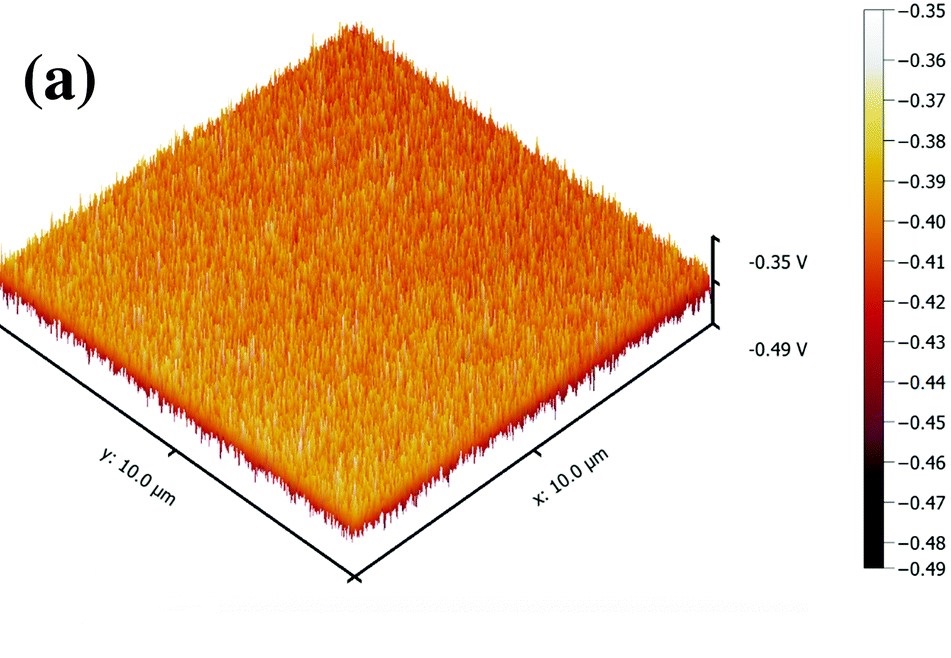Graphene, since its discovery in 2004 has attracted enormous interest due to its physical and chemical properties, and wide applications. *
Graphene oxide (GO) has emerged as an attractive alternative to graphene due to low cost, large scale production and solution processability. GO is prepared by oxidative exfoliation of graphite.*
The work function is a fundamental electronic property of a material and can be used to interpret the relative position of the Fermi level.*
For efficient transport of electrons or holes in a heterojunction device, the work function of the materials plays a crucial role, since work function determines how the bands will align at the contacts.*
Recently there has been an increased interest in applications of GO for interfacial layers and transparent electrode materials in optoelectronic devices e.g. liquid crystal displays (LCDs), organic light emitting diodes (OLEDs), touch screens, dye-sensitized solar cells (DSSCs) and as supercapacitor electrodes. Tuning the work function of GO is key to achieving high performance devices. *
In the article “Engineering work function of graphene oxide from p to n type using a low power atmospheric pressure plasma jet” by Avishek Dey, Paheli Ghosh, James Bowen, Nicholas St. J. Braithwaite and Satheesh Krishnamurthy, the authors demonstrate doping graphene oxide (GO) films using a low power atmospheric pressure plasma jet (APPJ) with subsequent tuning of the work function.*
The surface potential of the plasma functionalized GO films could be tuned by 120 ± 10 mV by varying plasma parameters. *
Scanning Kelvin probe microscopy ( SKPM ) also known as Kelvin probe force microscopy ( KPFM ) measurements were carried out to realize changes in work function of the GO films with plasma functionalization.*
NANOSENSORS™ PointProbe® Plus PPP-EFM AFM probes with a platinum iridium coating were used to perform surface potential measurements. *
The Kelvin probe studies showed that the bonding configuration can influence the work function of GO. Pyridinic nitrogen transforms GO to p-type while graphitic nitrogen increases the electron density of GO and transforming it to n type. Pointing to the fact that a low power APPJ can effectively tune the work function of GO and hence the conductivity. *
The findings presented in the article are extremely useful in fabricating heterojunction devices like sensors and optoelectronic devices where band structure alignment is key to device performance when GO is used as a charge transport layer. This technique can be extended to other known 2D systems.*

a) KPFM surface potential map of reference GO thin film ( please have a look at https://pubs.rsc.org/image/article/2020/CP/c9cp06174f/c9cp06174f-f10_hi-res.gif for the full figure.)
*Avishek Dey, Paheli Ghosh, James Bowen, Nicholas St. J. Braithwaite and Satheesh Krishnamurthy
Engineering work function of graphene oxide from p to n type using a low power atmospheric pressure plasma jet
Physical Chemistry Chemical Physics, 2020, 22, 7685-7698
DOI: 10.1039/C9CP06174F
Please follow this external link for the full article: https://pubs.rsc.org/en/content/articlehtml/2020/cp/c9cp06174f
Open Access: The article “Engineering work function of graphene oxide from p to n type using a low power atmospheric pressure plasma jet” by Avishek Dey, logoa, Paheli Ghosh, James Bowen, Nicholas St. J. Braithwaite and Satheesh Krishnamurthy is licensed under a Creative Commons Attribution 3.0 International License, which permits use, sharing, adaptation, distribution and reproduction in any medium or format, as long as you give appropriate credit to the original author(s) and the source, provide a link to the Creative Commons license, and indicate if changes were made. The images or other third party material in this article are included in the article’s Creative Commons license, unless indicated otherwise in a credit line to the material. If material is not included in the article’s Creative Commons license and your intended use is not permitted by statutory regulation or exceeds the permitted use, you will need to obtain permission directly from the copyright holder. To view a copy of this license, visit http://creativecommons.org/licenses/by/3.0/.